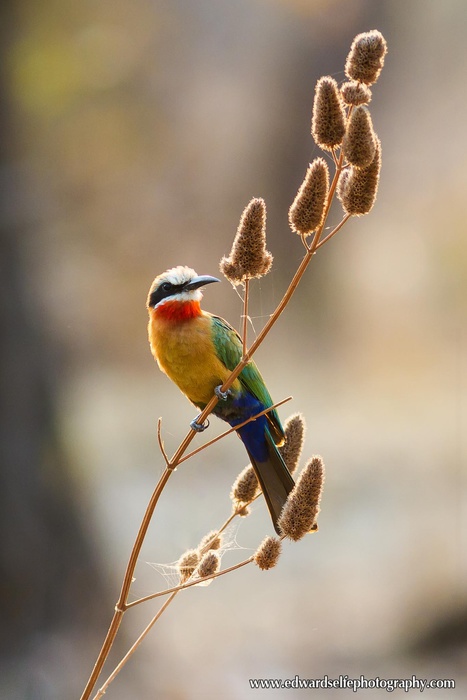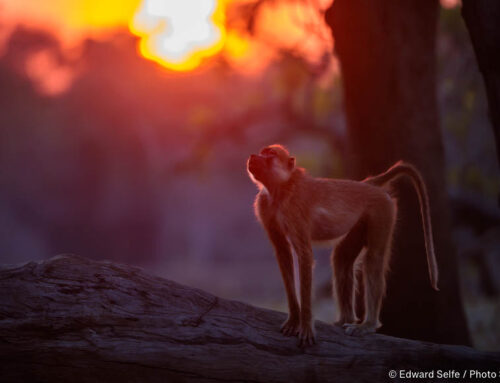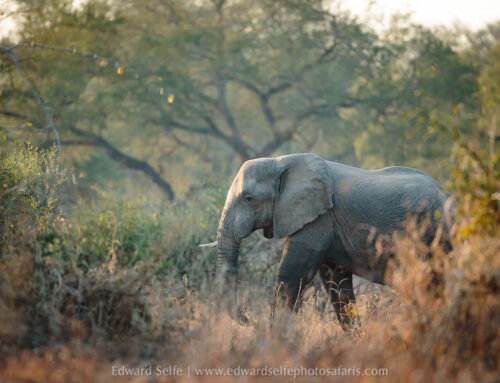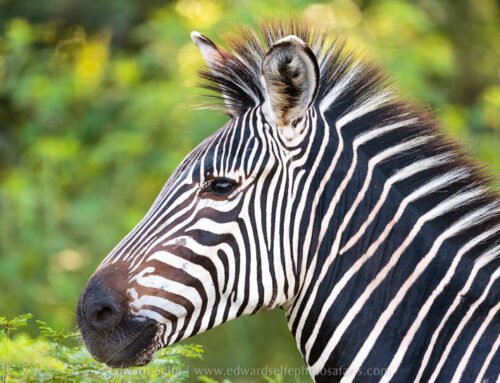I am going to add some details about the settings used to take the shot and why I chose them. I hope it’s interesting – please feel free to Share! So here goes….
Number 5: Backlit White-fronted Bee-eater
Canon EOS 7D, 300mm f4 lens at f4, ISO 800, 1/1600sec, EV -2/3 and Evaluative metering.
The bee-eater was using this Picnostachys spp. plant repeatedly as a launch point for aerial sorties to capture insects. I crept in slowly in my vehicle and set a negative exposure compensation, knowing that I would be shooting slightly backlit and I wanted to keep the “rim-lighting” effect. The bee-eater returned to the same spot and I snapped several shots on high-speed drive. It was important to use a high shutter speed (provided by the relatively high ISO) to ensure the bird’s movements were frozen; birds are always moving their heads, operating their third eyelid or twitching their wings, so a fast shutter speed is crucial to ensure a sharp image.
When I got home and saw the cobwebs between the plant’s branches, I was very pleased as I think they only add to the photo!

Number 4: Crowned Crane with chicks
Canon EOS 1D Mk 4, 500mm f4 lens at f5.6, ISO 1000, 1/500sec, EV 0 and Evaluative metering.
I have watched a pair of Crowned Cranes nesting in the same area of flooded grassland every rainy season since I arrived in Zambia. Whether they are exactly the same pair, I cannot tell (birds moult, of course, so any tell-tale feather-wear will be lost from year-to-year) but Cranes tend to pair for life and these two have always been very relaxed around people, which many others aren’t, so I think they are the same.
On this occasion, one of the adults was out with the chicks, teaching them to hunt for insects in the grass. I wanted to get a shot of the 3 of them, so I waited until they came into the open. I chose f5.6 because I wanted a little more depth of field in case the chicks weren’t the same distance from me as the adult, and I chose ISO 1000 to ensure that I had enough speed (1/500sec is fast enough for large birds at this distance). Then I just had to hope that I could get a clear background, and the soft tones of February bush colours gave me that!

Number 3: Golden Roller
Canon EOS 1D Mk 4, 500mm f4 lens + 1.4x teleconverter at f8, ISO 800, 1/800sec, EV 0 and Evaluative metering.
Lilac-breasted Rollers are by far the most photographed bird in Southern Africa! They are abundant and beautiful, but they don’t always sit around and wait for you to take a shot!
In this case, I was with a group of photographers and we decided to see how close we could get to a Roller. I found this one perched on a solitary twig, with golden grasses behind. Knowing that the distance between the bird and the background would give a smooth canvas behind, I parked at the top of a nearby rise and we rolled bit-by-bit towards the bird. Occasionally it would twitch, and I held the vehicle on the brakes, before rolling forward once more.
Beforehand, we had set cameras ready for the shot by pointing the camera at the grasses and taking a reading of ambient light. Stopping down one stop (from f5.6 to f8 in my case) ensured there was enough depth of field, even at the short distances we would be shooting over. The light was good so ISO 800 gave me 1/800sec which is enough for the stationary bird.

Number 2: Barn Owl in flight
Canon EOS 1D X, 500mm f4 lens at f4, ISO 3200, 1/250sec, EV 0, ETTL flash set to -1/3, and spot metering.
Night time photography with a flash is a whole different ball game. The full process is for another post, but suffice to say that this is one of the shots that I am most proud of! A combination of correct settings, good technique and a hefty dollop of luck gave me this beautiful owl!
Using the spot-light to acquire focus, I chose settings that would give an entirely black image without the flash (ISO 3200, f4 and 1/250sec would not even register the relatively dim light of the spotlight). Therefore, the illumination of the owl is done entirely by the flash – since flash guns’ light blast duration is extremely short (less than 1/2000sec) the flash serves to freeze the movement of the owl. Think of a strobe light making people’s movements look very jerky and you get the idea….
Barn owls are also rarely seen in the Luangwa, so I am doubly pleased to have got such a cool shot of this bird!

Number 1: Southern Carmine Bee-eater bringing food to nest hole
Canon EOS 1D Mk 3, 300mm f4 lens at f8, ISO 800, 1/2500sec, EV 0 and Evaluative metering.
My favourite bird photo – just when it all came together! A true spectacle of the Luangwa is the annual nesting display of the “Carmines”. Thousands of them pair off and then find a suitable spot in a river bank to form a breeding colony.
I spent many hours at this particular colony, trying to get a shot not only of a bird in flight, but of a bird in flight with the context of the breeding colony. I noticed that one hole was more frequently visited than the others, so I assumed that this pair already had chicks and two adults were feeding them. I trained my camera on the area of the bank, pre-focusing to help the Auto-focus system lock on, chose f8 to give more depth of field in case the AF was slightly in-accurate and then set a high ISO to get a fast 1/2500sec shutter speed.
It all worked out and I managed a series of shots of this bird approaching the nest hole with a food parcel in its beak. This was the best of the lot! So, have I cracked it? No, I now want a similar shot but with the head of the other adult poking out of the nest hole!




